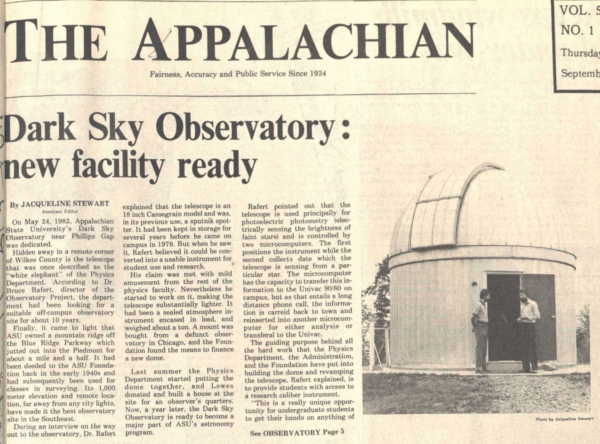Madalyn Edwards curated this story by Jacqueline Stewart, which The Appalachian published Sept. 2, 1982.
On May 24. 1982. Appalachian State University’s Dark Sky Observatory near Phillips Gap was dedicated.
Hidden away in a remote corner of Wilkes County is the telescope that was once described as the “white elephant” of the Physics Department. According to Dr. Bruce Rafert, director of the Observatory Project, the department had been looking for a suitable off-campus observatory site for about 10 years.
Finally, it came to light that ASU owned a mountain ridge off the Blue Ridge Parkway which jutted out into the Piedmont for about a mile and a half. It had been deeded to the ASU Foundation back in the early 1940s and had subsequently been used for classes in surveying. Its 1,000 meter elevation and remote location, far away from any city lights, have made it the best observatory site in the Southeast.
During an interview on the way out to the observatory, Dr. Rafert explained that the telescope is an 18 inch Cassegrain model and was, in its previous use, a sputnik spotter. It had been kept in storage for several years before he came on campus in 1979. But when he saw it, Rafert believed it could be converted into a usable instrument for student use and research.
His claim was met with mild amusement from the rest of the physics faculty. Nevertheless he started to work on it, making the telescope substantially lighter. It had been a sealed atmosphere instrument encased in lead, and weighed about a ton. A mount was bought from a defunct observatory in Chicago, and the Foundation found the means to finance a new dome.
Last summer the Physics Department started putting the dome together, and Lowes donated and built a house at the site for an observer’s quarters. Now, a year later, the Dark Sky Observatory is ready to become a major part of ASU’s astronomy program.
Rafert pointed out that the telescope is used principally for photoelectric photometry (electrically sensing the brightness of faint stars) and is controlled by two microcomputers. The first positions the instrument while the second collects data which the telescope is sensing from a particular star. The microcomputer has the capacity to transfer this information to the Univac 90/80 on campus, but as that entails a long distance phone call, the information is carried back to town and reinserted into another microcomputer for either analysis or transferal to the Univac.
The guiding purpose behind all the hard work that the Physics Department, the Administration, and the Foundation have put into building the dome and revamping the telescope. Rafert explained, is to provide students with access to a research caliber instrument.
“This is a really unique opportunity for undergraduate students to get their hands on anything of this size or quality. You don’t have graduate students kicking you out, and there are only two faculty lobbying for instrument time. In fact, 75 percent of the available time is for student use,” he said.
“Available time” means clear lights. But Rafert pointed out that there are different types of clarity. The photographic telescope which will be installed after this semester will not require the same cloudless conditions that photography demands. Fall, and spring and immediately after the passage of a cold front are definitely the best times for observing the stars, although there have been discouragingly few of them this summer.
The remaining 25 percent of available time is devoted to research. Rafert stated, however, that all student observations were in some way part of a research project.
The research program has four major components. The first is the study by photoelectric photometry, of binary stars—two stars that are dynamically bound together by their mutual gravitational attraction. Rafert said he likes to refine their astrophysical parameters rather than just their geometric ones. “This lets you tell things like how old these stars are and what sort of a sequence they might have gone through over the last hundreds of billions of years… to end up in the situation they are now.”
Because all branches of astronomy are highly interactive, Rafert said that one can deduce certain things from a particular branch that cannot be obtained from any other. “The more you learn about the masses, radii and luminosities of stars, the more you will know about their nuclear fusion. And eclipsing binary stars are one of the best ways of doing this. It is the only way,” he added.
The second broad category of research is photographic photometry. A 16 inch telescope has been donated to the Observatory and is being equipped for photography. Dr. Joe Pollock, Practitioner in Residence in the Physics Department, is building an off-set guider for the telescope and will be observing quasars once it is assembled. The latest theory on quasars is that they are sources of light on the edge of the universe whose amount of light cannot be explained in conventional terms of nuclear fusion, like our sun.
Yet another research project is the study of lunar occultations. When the moon blocks a star from view, it is not simply there one minute and gone the next. For approximately a quarter of a second the light of the star goes up a little before it goes out. The microcomputer is fast enough to trap the data collected during that fraction of a second, and from the information it gathers, the size of the star can be deduced.
The final component of the research program is comet recovery. But Rafert explained, it will not be able to get under way until the photographic telescope is ready for use. This fall Dr. Tom Rokoske, an expert on comets, will be keeping track of old ones and looking for new ones.
Dr. Rafert admits that this is a very ambitious program and one which will undoubtedly be whittled down. “We’ll probably settle for doing two out of four things. It would just be suicide to try to do them all. To do an adequate job we would just have to devote an incredible amount of time to all four areas.”
It is not as difficult as one might suppose to become a part of this challenging new program. Rafert said interested persons will need six hours of introductory astronomy in order to know the sky. One of these courses is called Descriptive Astronomy of the Solar System and deals with the astronomical phenomena within its physical boundaries, while the second is Descriptive Astronomy of the Stellar System and deals with the rest of the universe.
For the first time this fall the Astronomy Department will be offering Observational Astronomy I, in which photoelectric photometry and visual observations will be featured. In the spring there will be Observational Astronomy II, which will include photography and spectroscopy.
It all adds up to an exciting new facility, a little off the beaten track maybe, but part of ASU nevertheless. Its location is the envy of every serious astronomer on the East Coast. And it is all geared up and ready to go for you!



